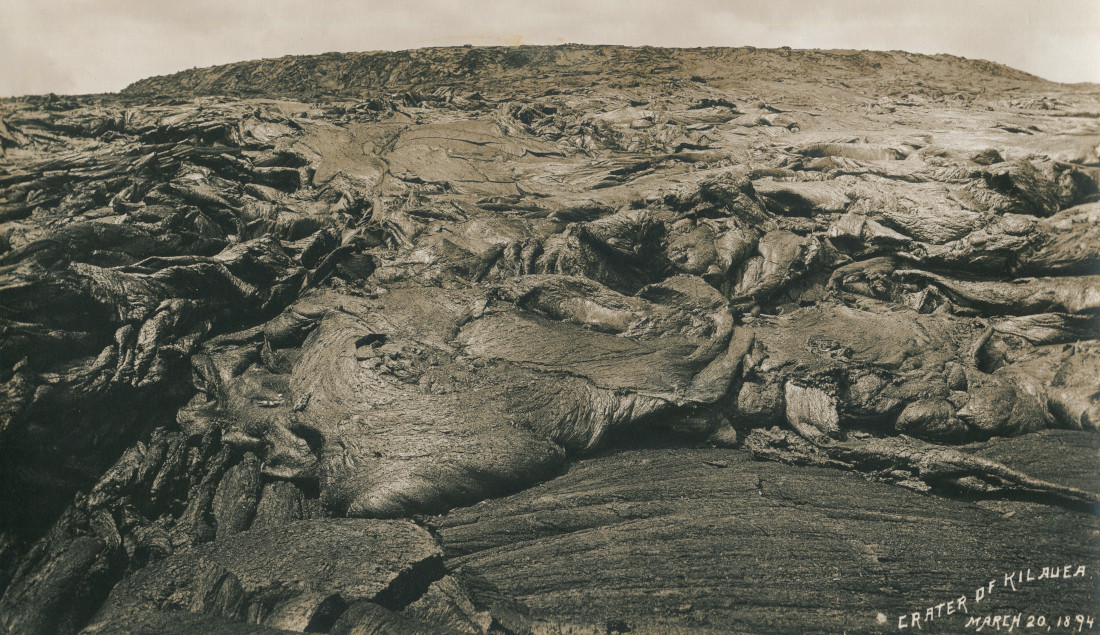
USGS: “Surveyor Frank Dodge’s 1894 cross-section of Halema‘uma‘u overlaid on his 1892 cross-section. The 1892 lava lake was measured at 73 m (240 ft) below the rim of Halema‘uma‘u pit and by early-1894, the lava lake had filled the pit and frequently overflowed onto the caldera floor. The overlay of these two cross-sections shows a minimum elevation of the 1894 lava lake.”
(BIVN) – The Kīlauea’s eruption is paused, and the USGS Volcano Alert level remains at WATCH.
The latest Volcano Watch article notes the Halemaʻumaʻu pit crater is currently filled to about 920 meters (3020 feet) above sea level, but the authors explain it has been much higher in the past.
From this week’s Volcano Watch, written by U.S. Geological Survey Hawaiian Volcano Observatory scientists and affiliates:
The 2018 collapse of southern Kaluapele (Kīlauea caldera) left a pit whose lowest point was about 500 m (1640 ft) above sea level (asl). Since 2020, that pit has filled to a little over 900 m (2950 ft) asl and one might wonder how high the lava level could go. We can’t answer that question but we can get an idea by looking to Kīlauea’s past.
The history of Kaluapele is a collection of periods of rising lava level within Halemaʻumaʻu, often to the point of overflowing, followed by abrupt and rapid drops in the level. After some time, the sequence repeats, rising to a slightly higher level. The process resembles a “two steps forward, one step back” sequence, with slowly rising lava level peaks.
The highest level of lava in the past two centuries was reached in the first few months of 1894, during years of repeat surveys by the Hawaiian Government. Rapid drops of the lava level occurred on March 6, 1886, and again exactly five years later on March 6, 1891. The final rapid drop of the 19th century began on July 11, 1894.
Frank Dodge, a surveyor with the Hawaiian Government Survey, mapped Halemaʻumaʻu in August 1892 and March 1894. The 1892 survey showed a lava lake 73 m (240 ft) below the rim of Halemaʻumaʻu pit and 160 m (522 ft) below the Volcano House veranda on the northeast rim of the caldera (elevation 1231 m or 4040 ft asl), then located about 150 m (490 ft) northwest of the current hotel. Elevations were measured multiple times with a surveyor’s theodolite to assure the highest accuracy possible. The lava level elevation was 1072 m (3518 ft) asl in August 1892.
The lava level continued to rise and, in the first months of 1894, visitors and residents found that lava frequently overflowed from Halemaʻumaʻu onto the caldera floor. They also noted that the pit crater was filled, and the lava lake was “on top of a nearly circular cone” or hill.
Dodge completed a follow-up map on March 20, 1894, confirming the filling of Halemaʻumaʻu pit and the rising of the lava lake above the 1891 pit rims. The lava lake was about 6 hectares (15 acres) in area atop a low shield on the caldera floor. Instead of multiple measures of elevation below the Volcano House, he only made one.
The 1894 map was excellent; however, Dodge’s quick measurement of the lava lake elevation relative to the Volcano House may have been wrong. After completing the map in 1894, he stated that the lava level rose “447 ft in 19 months” since 1892; however, in 1904, he began to doubt that measurement and he added a note in the margin of this map saying that the 447 ft (136 m) change may be too high.
Dartmouth Professor emeritus C.H. Hitchcock suggested a compromise: assume that, in March 1894, Halemaʻumaʻu was filled to the 1892 brim so the lava level rose by only 73 m (240 ft) between surveys. This ignored multiple reports and Dodge’s map of the lava lake being above the earlier rims.
Dodge responded that he could not accept Hitchcock’s suggested solution. “The height of the lava at the ‘supreme moment for Halemaumau’ will never be positively known…It was somewhere between the -75′ and -282′, referred to the Volcano House datum” (between 1145 and 1209 m asl).
In addition to the map, Dodge also drew August 1892 and March 1894 cross-sections of the Halemaʻumaʻu pit at the same scale. If we ignore the questionable datum line on the 1894 cross-section and overlay on the 1892 cross-section by matching slopes outside the pit, we can graphically estimate the highest elevation. This simple exercise shows that the March 1894 lake must have been at least 30 m (100 ft) above the 1892 brim. This all-time peak elevation was a minimum of 55 m (180 ft) below the Volcano House veranda or 1177 m (3860 ft) asl.
For perspective, the 2008–2018 5 hectare (12 acre) lava lake rose to 1034 m (3392 ft) asl just before its final drop during the 2018 summit collapse. The 2018 Halemaʻumaʻu pit crater (150 hectares or 370 acres) is currently filled to about 920 m (3020 ft) asl.
We have a long way to go to reach a new “supreme moment” for Halemaʻumaʻu.


by Big Island Video News7:41 am
on at
STORY SUMMARY
HAWAIʻI VOLCANOES NATIONAL PARK - This week's article by the USGS details how scientists know lava has "a long way to go to reach a new 'supreme moment' for Halemaʻumaʻu".